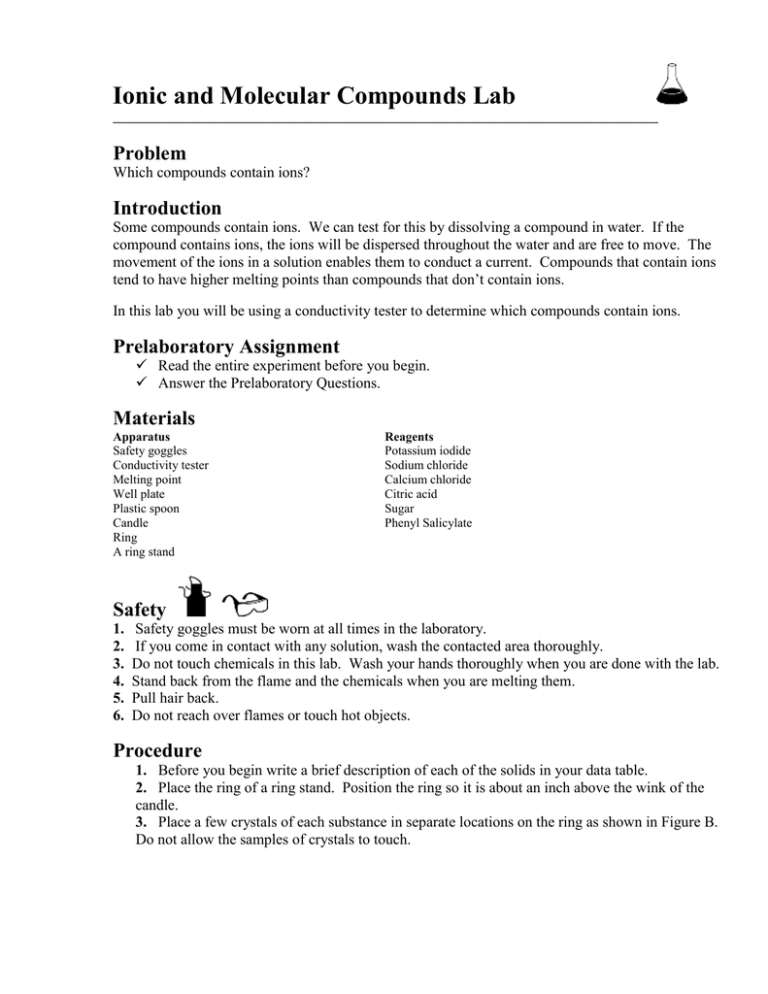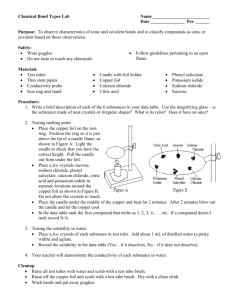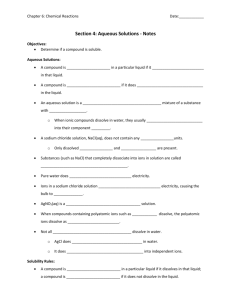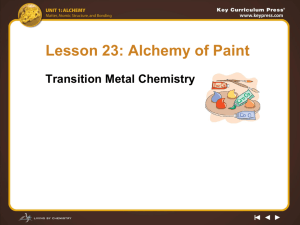Lab instructions procedure sheet
advertisement

Ionic and Molecular Compounds Lab _______________________________________________________________________________________ Problem Which compounds contain ions? Introduction Some compounds contain ions. We can test for this by dissolving a compound in water. If the compound contains ions, the ions will be dispersed throughout the water and are free to move. The movement of the ions in a solution enables them to conduct a current. Compounds that contain ions tend to have higher melting points than compounds that don’t contain ions. In this lab you will be using a conductivity tester to determine which compounds contain ions. Prelaboratory Assignment Read the entire experiment before you begin. Answer the Prelaboratory Questions. Materials Apparatus Safety goggles Conductivity tester Melting point Well plate Plastic spoon Candle Ring A ring stand Reagents Potassium iodide Sodium chloride Calcium chloride Citric acid Sugar Phenyl Salicylate Safety 1. 2. 3. 4. 5. 6. Safety goggles must be worn at all times in the laboratory. If you come in contact with any solution, wash the contacted area thoroughly. Do not touch chemicals in this lab. Wash your hands thoroughly when you are done with the lab. Stand back from the flame and the chemicals when you are melting them. Pull hair back. Do not reach over flames or touch hot objects. Procedure 1. Before you begin write a brief description of each of the solids in your data table. 2. Place the ring of a ring stand. Position the ring so it is about an inch above the wink of the candle. 3. Place a few crystals of each substance in separate locations on the ring as shown in Figure B. Do not allow the samples of crystals to touch. 4. Light the candle. Record the order in which the substance melt. 5. After 3 minutes, record which substance did not melt. Blow out the candle and allow the can lid to cool completely before cleaning. 6. Half-fill seven wells with distilled water. 7. Add the following to each well Well 1: nothing Well 2: a few crystals of sugar Well 3: a few crystals of sodium chloride Well 4: a few crystals of potassium iodide Well 5: a few crystals of citric acid Well 6: a few crystals of phenyl salicylate Well 7: a few crystals of calcium chloride 8. Use the conductivity testers provided by your teacher to test each well. Carefully place the tips of the tester into the solution. Record your observations. 9. For the solutions that caused the bulb to light, use a pipette to place a few drops of each solution into separate wells. Add water to each well until it is almost filled. 10. Use the conductivity testers to test each of your diluted solutions. Record your observations. Cleaning Up 1. Clean up all materials and wash your hands thoroughly. 2. Dispose of all chemicals as instructed by your teacher. Name___________________________________________ Hour___________Date____________ Prelaboratory Questions 1. Why does the bulb light? What does it mean if the bulb doesn't light? 2. Why did we add the conductivity of the water? Data/Observations 1. Record your observations in the table below. Name Description Melting Point Did the bulb light? Conc. Dilute Water (H2O) Dextrose C6H12O6) sodium chloride (NaCl) calcium chloride (CaCl2) potassium iodide (KI) citric acid (H3C6H5O7) Phenyl Salicylate (C13H10O3) Analysis Questions 1. Organize the substances into two groups according to similar properties. 2. List the properties of each group. Are these properties chemical or physical in nature? 3. Look at the chemical formulas of each substance. Locate the metals in the formulas. How are the compounds that had high melting points similar? 4. True or false: The reason a compound did not cause the bulb to light is because the substance did not dissolve in water. Explain your answer. 5. Explain what happened when you added water to the solutions that caused the bulb to light by using molecular level pictures. This video might help: www.tinyurl.com/saltsolution 6. How could we tell if a compound consisted of ions if it does not dissolve in water? Conclusion: Summarize the differences between ionic and molecular substances. What experimental methods could you use determine what kind of bonding exists in a substance?





